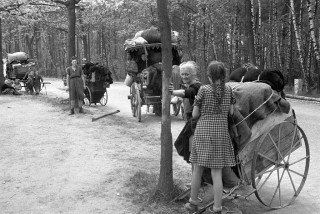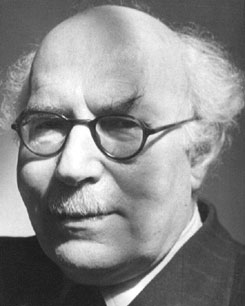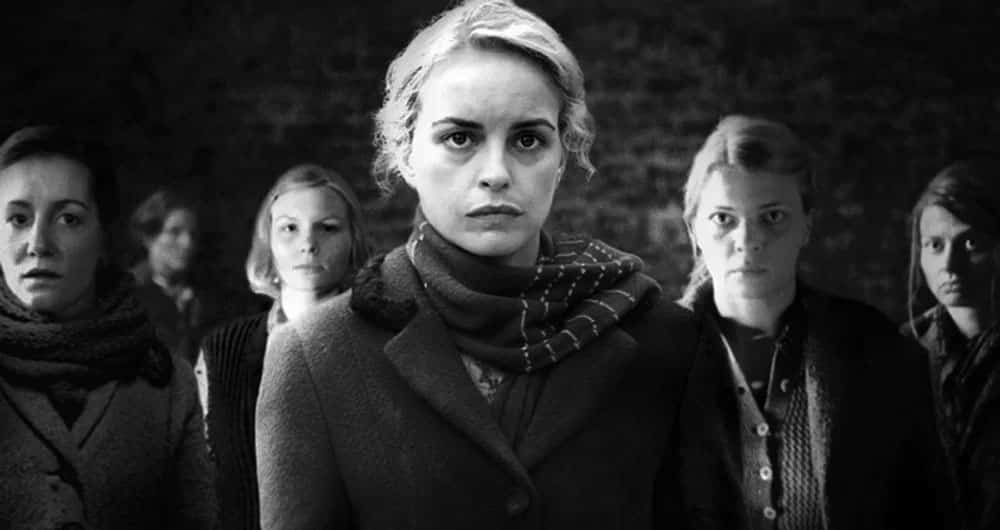“There is not one German who has not murdered our fathers. Every German is a Nazi. Every German is a murderer.” Menachem Begin, former Prime Minister of Israel[1]
We have seen in previous articles how the word “Holocaust” itself has progressively become a potent weapon in the ideological war. But the Holocaust establishment has worked tirelessly over the past few years to ensure that this weapon is spread across the world, including Asian countries. Last January, the New York Times had an article entitled, “Raising Asian Awareness of the Holocaust.”[2]
Throughout the entire article, nothing was said about Stalin’s extermination programs, which eventually were responsible for the death of millions upon millions of Russian peasants.[3]

Nothing was said about Mao’s slaughterhouses and execution programs, which killed at least 45 million people;[4] nothing was even remotely mentioned about China’s eugenic program, which literally obliterated millions of innocent lives,[5] and about Vietnam’s communist regime, which brutally massacred millions of people.[6]
In the twentieth century alone, many Asian countries were infected by the communist virus, which ended up killing at least fifty million people just in Asia alone.
What the New York Times ended up saying indirectly was that Asia does not have enough “Holocaust” problems; Asia, which is where this writer currently resides, needs to consider the only Holocaust in recent memory: Nazi Germany. In short, the new doctrine is pretty straightforward: Thou shalt have no other gods before the Jewish “Holocaust”!

If the New York Times wanted Asians to have a good history lesson, they certainly should have mentioned Stalin and others as well. That certainly betrays their prejudice.
Moving on to the Middle East, Palestinian President Mahmoud Abbas has recently called the “Holocaust” “the most heinous crime” in modern history. It seemed that he was trying to appease the Israelis, who didn’t even acknowledge the apology. In response, Benjamin Netanyahu declared,
“Instead of issuing statements designed to placate global public opinion, (Abbas) needs to choose between the alliance with Hamas, a terrorist organization that calls for the destruction of Israel and denies the Holocaust, and a true peace with Israel.”
President Abbas perhaps didn’t know what happened to the Germans after World War II, our topic in this article.
Then we have Steven Spielberg recently saying that “Mass graves don’t have to open up before we act…It took me years of directing sharks, aliens, and dinosaurs before I felt ready to tackle the Holocaust.”[7]
After the release of Schindler’s List, Spielberg founded the Shoah Foundation Institute at the University of Southern California. If you think Spielberg is going to help found a similar institute for the innocent Russians, Chinese, and Germans who died after the war, think again.
After World War II, 12 to 14 million German people—including women and children under the age of sixteen—were brutally driven from their homes.[8] Some historians place the figure as high as fifteen million.[9]
During the expulsion, thousands lost their lives from starvation, disease, and ill-treatment. Some died in wagons without food, water, or heating during long trips; others collapsed by the roadside. The death estimate is between 500,000 and 1.5 million.[10] Other historians estimate that the figure amounts to 2 million.[11]
Moreover, thousands upon thousands of children were separated from their families.[12] Historian R. M. Douglas notes that many of these issues are not discussed among popular historians and are even ignored in some scholarly circles.
“Today, outside Germany, they are almost completely unknown. In most English language histories of the period they are at best a footnote, and usually not even that.
“The most recent (2009) edition of Mary Fulbrook’s excellent History of Germany 1918-2008 disposes of the episode in a single uninformative paragraph…The Cambridge Illustrated History of Germany is typical in not according the expulsions even a single mention.”[13]
Historian Pertti Ahonen likewise declares that “The political dimensions of the expellee problem in the Federal Republic form a particular of neglect” and the accurate history of the expellees remains
“poorly investigated, especially on the federal level, despite the obvious importance of the newcomers’ political integration for the Federal Republic’s stability.”[14]

Some historians dismiss these accounts as “wild expulsions,” while others defend the position that the Allies were justified in brutally turning out the Germans.[15] Some historians, such as Keith Lowe, have even gone on record saying that the brutality and vengeance against German civilians “tended to be a small-scale affair.”[16]
This was not the case. While Lowe concedes the fact that German women were brutally raped and other shameful acts were committed on women in places like France, Italy, Denmark, and Holland,[17] he prefaces these facts by saying that they were done on a minor scale, which seems to be contradictory. He writes,
“The sexual nature of the rituals themselves is also significant. In Denmark the women were frequently stripped naked during their head-shaving ceremonies, and their breasts and backsides painted with Nazi symbols.
“In many areas of France women also had their bare bottoms spanked, and their breasts daubed with swastikas.”[18]
But the “sexual nature” cannot be “significant” if it was done on a minor scale or if it was limited to a small area. Then Lowe knocks himself out by saying
“it is difficult to judge, at a distance of some seventy years, whether these women deserved to be punished in this way, in an alternative way, or not at all.”
He cites British Foreign Secretary Anthony Eden saying that “those who had not been through the ‘horrors of occupation’ had no right to pronounce upon what a country does.’”[19] Lowe’s analysis here is so morally untenable as to hardly deserve a rebuttal—on what grounds, then, can he condemn Nazi Germany?

There is much to be learned from his book Savage Continent. He argues quite rightly that after the war German children faced enormous discrimination in the nation in which they were born. For example, the Norwegian daily newspaper, Lufotposten, wrote of the German children who were growing up in the country:
“All these German children are bound to grow up and develop into an extensive bastard minority in the Norwegian people. By their descent, they are doomed in advance to take a combative stance.
“They have no nation, they have no father, they just have hate, and this is their only heritage. They are unable to become Norwegians. Their fathers were Germans, their mothers were Germans in thought and action. To allow them to stay in this country is tantamount to legalizing the raising of a fifth column.”[20]
The war brought unwanted baggage to the German civilians, and ethnic German children who grew up in places like Norway faced tremendous pressure, including rejection by their own families.[21] This has had detrimental effects on generational children who, according to a 2001 study,
“suffer higher death rates, higher divorce rates and worse health than the rest of Norway’s population…They are also significantly more likely to commit suicide than their peers.”[22]
Norman Davies states,
“For every European who was involved in the fighting of the Second War, there were at least ten civilians who were not directly involved but who nonetheless were forced to suffer the painful consequences of international conflict.”[23]
Douglas argues that the expulsions, along with rape on a massive scale, were meticulously “carried out by troops, police, and militia, acting under orders and more often than not executing policies laid down at the highest levels.”[24]
For example, when a Czechoslovak soldier carelessly discharged his weapon, wounding himself, German civilians were to blame and at least nine of them were executed.[25]
Similarly, twenty local Germans were shot because “an SNB officer accidentally blew himself up in Bruntal while handling a grenade.”[26] Even before the war was over, ordinary Germans were destined to pay the price of World War II. In January 1945, the Soviets torpedoed the German cruiser Wilhelm Gustloff, which was carrying about 9,000 refugees, “4000 of whom were children.”[27]

After the war, the Allies re-established concentration camps for national and ethnic Germans.
“Many of the Sudeten German Social Democrats who were put in concentration camps by the Germans for being anti-Nazi when liberation came were transferred to Czech labor camps merely because they were of German origin.”[28]
For example, “Hrnecek personally took revenge on his former captain in the Ceske Budejo-vice police force by pole-hanging the man for four to five hours while having him ‘beaten with cow-hide horsewhips’ until he fainted, and resuscitating him by pouring water over him.”[29]
Similar torture in those camps happened almost every night, which resulted in an increase in suicides among the prisoners.[30]
“Many ex-Nazi concentration camps like Majdanek or Theresienstadt—and even the camp at Auschwitz—never went out of business, but were retained in operation as detention facilities for ethnic Germans for years after the war.”[31]
Moreover,
“the former Konzentrationslager of Boleslawiec (Bunzlau), a subcamp of Gross-Rosen in Poland, held approximately twelve hundred boys aged between twelve and fifteen, who were used as forced labor on road-building projects.
“Of the ninety-five inmates of the children’s camp at Ceske Kridlovice in Czechoslovakia during the month of July 1947, a third were under six years of age.”[32]
Similar reports have surfaced—in other concentration camps such as Mirosov, many prisoners were “younger than fourteen years of age; forty-five of them were below the age of six.”[33]
Those camps represented “a system of organized and ferocious maltreatment of internees, with the stated intention of completing in five months what the Nazis had failed to accomplish at the camp in five years.”[34]
By June 1945, ordinary Germans were forced out of their homes and made to walk hundreds of miles with no food and water. One survivor wrote,
“Many weak and sick people, old folks, and children had to be left on the road dead. It was a lamentable procession of utmost misery…Heaven only knows how often we were plundered by Poles or Russians and how many times the women were assaulted again and again.”[35]
Sexual torture happened on a large scale, so large in fact that Douglas called it “ritualized sexual humiliation and punishment suffered by female inmates.”[36] One particular woman, Johanna Janisch, was raped “some twenty times by Red Army soldiers,” and contracted gonorrhea as a result.[37]
Between May and August 1945, some places “functioned as a sexual supermarket,” whose detainees, ethnic Germans, were brutally raped.[38] At Potulice, one of the largest Polish camps for Germans,
“the sexual humiliation of female prisoners had become an institutional practice by the end of 1945.”[39]

In Czechoslovakia, torture by the Revolutionary Guards included “exposing women’s body parts and burning them with lighted cigarettes.”[40] The male detainees sometimes “were compelled to perform sexual acts upon each other.”[41] (Sounds like a precursor to Abu Ghraib.)
Reports given by the Belgrade embassy in 1946 concurred.[42] In contrast,
“Women survivors of German concentration camps have recalled that, notwithstanding the unrestrained brutality that pervaded most other aspects of daily life, rape or other forms of sexual maltreatment at the hands of their guards was an extremely rare occurrence, and severely punished by the authorities if detected.”[43]
Adrian Kanaar, a British military doctor, actually witnessed the brutal torture which the Allied forces inflicted on ordinary Germans. He later wrote that he was willing to face court martial for raising public awareness with regard to the Germans and declared that the Allied forces had established “a tyranny…which is as bad as the Nazis.”[44]
Ignacy Cedrowski, the camp physician at Potulice between 1945 and 1948, lost his family during the Nazi era and was a survivor of Auschwitz. He was appalled at how the Allied forces were treating the Germans.[45]
John Colville, a former private secretary of Winston Churchill, noted the same thing, adding that “concentration camps and all they stand for did not come to an end with the defeat of Germany.”[46]
Yet even after all these events, the vast majority of the ordinary Germans remained servile.[47] Catholic priest Josef Neubauer, who was in one of those camps until November 1945, wrote:
“On June 27, 1945, I was suddenly ordered to the guard room. There I was made to strip completely naked and was beaten with sticks and fists. As a result, one of my ribs was broken and my teeth were knocked out.
“I then received at the hand of my two tormentors another 50 strokes with a length of steel cable, the thickness of my thumb, on my stomach, back, chest, and buttocks. I was made to count the blows myself. At the end of this beating, my entire body was bleeding.
“I told my tormentors that I forgave them and that God should not count it as a sin against them. They were baffled by this statement of mine and from that moment onward left me in peace.”[48]

Western responses to those atrocities have been appalling. The life of Johannes Kostka, a German prisoner of war in a British camp in Egypt, is a case in point.
By the end of 1947, Kostka wrote a letter to the U.S. Office of Military Government in Frankfurt about his wife Gertrud, a detainee in the Southwestern Polish town of Bielsko-Biala. Kostka was separated from his wife for four years and finally got a letter from her, which he passed on to the U.S. agencies.
His wife was pregnant as a result of rape and had contemplated suicide. The United States passed the letter to the British embassy in Warsaw, but in the end, both countries decided to drop the issue. The British embassy finally declared that “we propose that [the case] should be dropped.”[49]
Moreover, in most of the camps, the Red Cross and other humanitarian organizations were prevented from providing assistance. There was no organization working on the behalf of the detainees, despite the fact that their mistreatment was widely known (though only a few Americans knew about it).[50]
(This is similar to what we are seeing with respect to Israeli mistreatment of Palestinian children.[51]) When the war was over, the vast majority of polls in Britain, France, and the United States made no distinction between “ordinary Germans” and “Nazis.” Not only that,
“Some carried [the] perception…that it was appropriate even that children pay the price for Nazi misdeeds.
“When the London-based National Peace Council issued a call in September 1945 for Britons to accept reduced food rations so that expellee women and children might be fed, a correspondent to the Daily Herald condemned those among his countrymen who still harbored ‘tender feelings towards this race of murderous white savages.’”[52]
Some Allied officers such as Goronwy Rees ascribed similar views.[53] A few voices, such as Jewish publisher Victor Gollancz, made it clear that if ordinary Germans were going to be held accountable for what happened in Nazi Germany, then the United States and Britain must collectively be responsible for what was being done to the German civilians. Other voices within the Christian community, most particularly the Church of England, protested against the massive expulsions of the Germans.[54]
In August 1945, when the British arrived on German shores,
“A convoy of trucks pulled into the village, and the Tommies took over from an easygoing US infantry division. Within hours, the British had ordered everybody in the center of the village to pack their belongings and leave.
“Bad Nenndorf was heaving with refugees from the bomb-ravaged ruins of Hanover, 18 miles to the east: hundreds of people were given 90 minutes to pack some food and valuables, and get out.
“‘We thought everyone would be allowed back in a few days,’ recalls Walter Münstermann, now a retired newspaperman, but then a 14-year-old.
“‘Then the soldiers started putting barbed wire fences around the center of the village, and slowly we began to realize that this was going to be no ordinary camp.’”[55]
Bad Nenndorf, the place where the prisoners were kept and tortured, “became known as das verbotene dorf—the forbidden village.”[56]

Instead of crying out only against Nazi concentration camps, popular history books should decry all concentration camps, Nazi as well as Soviet, where millions of non-Jews were sent during and after World War II.
The fact that the Holocaust establishment rarely discusses these issues tells us that they are only interested in propagating ideologies as opposed to real history.
The time to move to the next chapter of history and discuss what happened after the war is long overdue. Serious historians cannot live in fear anymore and cannot afford to follow an ideology as opposed to real history.
Noted British historian Giles Macdonogh writes that after the war,
“In most cases, it was not the criminals who were raped, starved, tortured or bludgeoned to death but women, children, and old men.”[57] It proved to be devastating, “, particularly for civilians.”[58] The Red Army
“raped wherever they went. They even raped Russians and Ukrainians. The worst and most aggravated rapes were perpetrated against the women of the enemy—first the Hungarians, then the Germans.”[59]
MacDonogh notes that raping women was probably viewed as “a form of vengeance against these ‘superior women and the best way to humiliate them and their menfolk.”[60]
Historian Alfred Maurice de Zayas likewise notes that “one of the aberrations practiced by the soldiers was to take victims, mostly female, strip them naked and nail them to barn doors in cruciform fashion. This one particular atrocity features prominently in many eyewitness reports.”[61] Road signs read, “Soldier: you are in Germany, take revenge on the Hitlerites.”[62]
Historian Antony Beevor says that the Soviet propaganda of hatred towards the Germans started in 1942.
“Every opportunity had been taken to drum in the scale of German atrocities in the Soviet Union. According to a French informant, the Red Army authorities exhumed the bodies of some 65,000 Jews massacred near Nikolayev and Odessa, and ordered them to be placed alongside the road most used by troops. Every 200 meters a sign declared, ‘Look how the Germans treat Soviet citizens.’”[63]
The political department of the 1st Ukrainian Front declared, “We were constantly trying to step up hatred towards Germans and to stir up a passion for revenge.”[64]
General Ivan Danilovich Chernyakhovsky, who “used to recite poetry with humorous panache” to Ilya Ehrenburg, told his soldiers when they reached East Prussia in January, “Soldier, remember you are now entering the lair of the fascist beast!”[65]

This is not a surprise at all, for Ehrenburg was the author of the novel The Unusual Adventure of Julio Juarenito and his Pupils, in which we find the phrase, “Murders must be committed for the well-being of mankind.”[66]
When a person of some reputation in Great Britain declared that Ehrenburg needed to abandon his “lust for revenge,” Ehrenburg wrote back,
“My mother is religious too, and in the name of religion, she asks, ‘kill the Germans with my blessings…One must not pity a wild beast…rather, one must destroy it.”[67]
When Ehrenburg actually saw what the Red Army was doing to the Germans, he “was deeply shaken on a visit, but it did not make him moderate his ferocity in print.”[68] A Soviet soldier remembered,
“There was a big slogan painted up in our canteen, ‘Have you killed a German yet? Then kill him!’ We were very strongly influenced by Ehrenburg’s appeals and we had a lot to take revenge for.”[69]
Historian Richard Bessel declares that the soldiers “unleashed an orgy of wanton destruction…There could be no motive for such destruction other than revenge against a now helpless German population.”[70]

In his last article of the war, Ehrenburg wrote,
“Germany is dying miserably, without pathos or dignity. Let us remember the pompous parades, the Sportpalast in Berlin, where Hitler used to roar that he was going to conquer the world.
“Where is he now? In what hole? He has led Germany to a precipice, and now he prefers not to show himself…Germany does not exist; there is only a colossal gang.”[71]
A talented propagandist, Ehrenburg delivered lectures at the Frunze military academy, condemning what the Red Army was doing and “blaming it on the troops’ ‘extremely low’ level of culture.”
When it came to rape, Ehrengurg’s only defense was that Soviet soldiers “were not refusing ‘the compliments’ of German women.”[72]
Certainly, the Red Army took Chernyakhovsky’s and Ehrenburg’s message seriously, as they went out to put churches and civilian buildings to the torch and raped women in West Prussia and Pomerania; many of the victims committed suicide afterward.[73] One testified that she had been raped thirteen times.[74]
Other crimes against civilians in Pomerania were widespread during the first week of occupation.
“Near the Puttkamers’ village, an elderly couple was chased into the icy waters of a village pond, where they died. A man was harnessed to a plow, which he was forced to drag until he collapsed.
His tormentors then finished him off with a burst of sub-machine-gun fire. Herr von Livonius, the owner of an estate at Grumbkow, was dismembered and his body thrown to the pigs. Even those landowners who had been part of the anti-Nazi resistance fared little better.
“Eberhard von Braunschweig and his family, assuming that they had little to fear, awaited the arrival of the Red Army in their manor house at Lubzow, near Karzin. But his reputation and numerous arrests by the Gestapo did him little good. The whole family was dragged outside and shot.”[75]
When Chernyakhovsky died, Marshal Vasilevsky took over and was told about the looting and damage that the Red Army was doing. After a moment of silence, “Vasilevsky, perhaps the most intelligent and cultivated of all Soviet commanders,” said, “‘I don’t give a [expletive]. It is now time for our soldiers to issue their own justice.’”[76]

The German civilians, those “fascist beasts,” had to pay a terrible price for the Soviet’s perception of what the Nazis had done. One playwright of the time, Zakhar Agranenko, wrote:
“Red army soldiers don’t believe in ‘individual liaisons.’ Nine, ten, twelve men at a time—they rape them on a collective basis.”[77]
“Burn their homes to the ground and enjoy the flames. These were the messages that permeated the last years of the war. Marshall Zhukov’s orders to the First Belorussian Front on the eve of the January 1945 offensive into Poland did little to dampen the Soviet soldier’s lust for revenge:
“‘Woe to the land of the murderers,’ the orders stated. ‘We will get our terrible revenge for everything.”[78]
One of the Red Army Field Postal Service letters stated:
“And now we take our revenge on the Germans for all their despicable acts committed against us. We’re being allowed to do what we please with the German scoundrels. German mothers shall rue the day they gave birth to a son. May German mothers now feel the horrors of war firsthand.
“What they wanted to do to other people they will now experience themselves! We spend the night in their houses and drive the Germans out into the cold, just like they did to us. There are only old people and children in Germany, very few girls. But we kill them all anyway.
“Now we’re meeting up with German civilians, and our soldiers are making good use of German women. There are plenty of women around, but they don’t understand a word of Russian. But that’s even better because you don’t have to talk them into it.
“Just aim the Nagan [pistol] and shout, “Lie down!”…take care of your business and be off…Our boys have already tried out all the German women.[79]]
Norman Naimark notes that although the reasons for raping and torturing German women were many, one of the primary reasons was that the Russians were directly motivated by vengeance.
Rape “was not fundamentally motivated by sexual needs,” Naimark argues, but “is a crime of violence.” To say that “war breeds rape” does not explain the fact that not only did the Soviets rape women on a massive scale, but that long before they came to Germany, they propagandized “more reason for revenge.”[80]
“Throughout the Soviet press, the idea was widespread that the Germans—women on the home front included—would have to ‘pay’ for their evil deeds.”[81]
The social history of rape was largely “unknown to the Western zones.”[82] “It was not untypical for Soviet troops to rape every female over the age of twelve or thirteen in a village, killing many in the process…The reports of women subjected to gang rapes and ghastly nightly rapes are far too numerous to be considered isolated incidents.”[83]

On February 26, 1945, the Soviets captured one German village and “systematically plundered” it. “Virtually all of the women were raped. ‘The screams of help from the tortured could be heard day and night.’”[84]
When the Soviets finally overtook the city of Budapest, one observer, Julius Hay, noted,
“It was impossible to spend a day or even an hour in Budapest without hearing of brutalities committed by [Russian] soldiers.”[85]
On other occasions, “Hungarian girls were locked in Soviet quarters on the Buda side of the city, where they were repeatedly raped and sometimes killed.”[86] In the city of Rostock, “women and girls were raped in the presence of their children and parents.”[87]
During these circumstances, the German police could do little to stop the violence, since the Soviet soldiers would not hesitate to shoot any police who intervened. Naimark notes that
“the police archives are filled with complaints about the [German police’s] inability to protect German women from rapists ‘in the uniform of the Red Army.’”[88]
On a few occasions, women would resist the rapists, but they ended up “brutally beaten or killed as a result.” On other occasions, when the attacker was alone, some Germans did not hesitate to show strong resistance:
“In one such instance, a group of young people who beat up a Russian soldier attempting to rape a German girl were arrested by the police for being alleged Werewolves—members of the underground Nazi youth.
“In another, a German policeman was shot and killed while trying to stop the rape of a woman. In the third, the Ministry of International Affairs operations group arrested a German policeman who had seized the Russian rapists.”[89]
There were a number of Russian officers who “were terribly ashamed of the behavior of their compatriots,”[90] and there were a few soldiers punished for their crimes,[91] but that happened only on rare occasions. Raping and plundering were commonplace.
And no one was spared. German women were even raped at transportation centers and railway crossroads, where railway officials could do little to stop the situation.[92] Farmers “who refused to turn over goods to the Soviets or who resisted rape attempts were shot and sometimes killed. Isolated farmhouses were broken into and the women were raped.”[93]
Aleksandr Solzhenitsyn was a young captain in the Red Army during that time, and he strongly opposed brutal abuse against women and the German people; for that, he was sent to the Gulag. He wrote in 1945:
“Yes! For three weeks the war had been going on inside Germany and all of us knew very well that if the girls were Germans they could be raped and then shot. This was almost a combat distinction.”[94]
Rape, “from 1945 to the end of 1946 or the beginning of 1947…became a part of everyday life in the remote villages of Burgenland and Lower Austria.”[95]
Moreover, there seemed to be no age limit, for there were reports that “women as old as eighty” were also victims of the Red Army.[96] And women were raped numerous times; at least one woman by the name of Wanda was raped 128 times.[97]
One sixteen-year-old girl, who had been repeatedly raped, “drowned herself in the Stau Lake.”[98] Nuns were not spared either,[99] and some were reported to have been raped as many as fifty times.[100] Naimark notes that even when German women
“entered bunkers and cellars where Germans hid from fierce fighting, Soviet soldiers brandished weapons and raped women in the presence of children and men. In some cases, soldiers divided up women according to their tastes. In others, women were gang-raped.
Generally, the soldiers raped indiscriminately, not excluding old women in their seventies or young girls.”[101]
Antony Beevor recounts the same thing. After three days, “the women tried to kill the children and themselves by cutting all their wrists, but evidently, they had not known how to do it properly.”[102]
When rape was the norm, consequences followed:
“Women committed suicide after the event; many contracted venereal diseases; others became pregnant and had to seek abortions.”[103]
Soldiers were punished for raping women “only if they caught the venereal disease from victims, who had usually caught it from a previous rapist.”[104] Today, some Soviet historians, as Antony Beever puts it,
“still produce evasive circumlocutions. ‘Negative phenomena in the army of liberation,’ writes one on the subject of mass rape, ‘caused significant damage to the prestige of the Soviet Union and the armed forces and could have a negative influence in the future relations with the countries through which our troops were passing.”[105]
Abortions, which were illegal in Germany at the time, were done under extreme conditions.
In concentration camps, men and women were forced to perform sexual acts:
“Men and women were stripped naked and forced to perform sadistic acts on one another or eat excrement; girls had to press burning banknotes between their legs. There were many small children in the camp. Some of these were later taken away and given to Polish foster parents.”[106]
Like in our modern day, Jews who stood up against such immorality were severely punished. “When the Ukrainian Jewish intellectual Lev Kopelev tried to intervene to save a German woman from a group of rampaging soldiers, he was accused of ‘bourgeois humanism’ and imprisoned for nine years.”[107]
East Prussia was the first German territory that the Red Army visited. “In the course of a single night,” writes MacDonogh, “the Red Army killed seventy-two women and one man. Most of the women had been raped, of whom the oldest was eighty-four. Some of the victims had been crucified.”[108]
Russian soldiers broke into at least one hospital operated by surgeon Hans Lehndorff and robbed
“his patients of their watches, beating up anyone who stood in their way. One of the attackers, ‘a really young fellow, suddenly burst into tears because he had yet to find a watch. He struck three fingers in the air. He was going to shoot the people if he did not get one at once.’ They found him a watch.”[109]
Watches were so important to them because of their “inability to master anything technical,” and it was considered as “an inexhaustible chapter.”[110] They not only stole watches, but
“all the bicycles they could find. [One woman] saw them take them up to a street near the Hasenheide where they practiced riding them. They sat ‘stiff on the saddles like chimpanzees in the zoo.’ They frequently fell off before they mastered the use of the two-wheeled beast. Many bicycles were broken in the process and the wreckage strewn over the street.”[111]
The next day, “swarms of soldiers attacked the population as they ventured out of the warrens they had inhabited during the long siege. They were beaten, robbed, stripped, and, if female, raped.”[112]
Given those horrible circumstances, “a very large number of [the populace] took their own lives to escape the indignity of Soviet revenge.”[113] The soldiers quickly contracted sexually transmitted diseases.
When that happened, they would burst into hospitals and “demanded treatment at gunpoint.”[114] But nothing dimmed their undying hatred toward the Germans:
“Those who lived in the villages of East Prussia fared no better than the townsfolk. A witness who made it to the west talked of a poor village girl who was raped by an entire tank squadron from eight in the evening to nine in the morning. One man was shot and fed to the pigs.
“Another woman tried to take the last train from Mohringen, but it was derailed and the passengers proceeded on foot, only to run into the Russians. She describes these soldiers breaking into a farmhouse and finding an Iron Cross, Second Class.
“The owner of the decoration and his wife were taken out and shot in the back of the head. The narrator herself was raped around twenty times the night she was captured, but there was worse in the store. She was carried off by two officers and seven men, whom she suspected were deserters, or temporarily estranged from their unit.
“They lodged her and eight other females, including a fourteen-year-old girl, in a house in the forest, where they raped them for a week. Their ordeal came to an end only when the GPU, the secret police, found the house. The woman was then taken to Insterburg and shipped beyond Stalingrad to the north-eastern Urals.
“She was in a carriage with fifty women for three weeks. During that time she had only two hot meals. The guards gave them salted herrings.
“They were so thirsty that they licked the condensation off the window panes. Five of the women had died by the time they reached their destination. They were suffering from typhus, dysentery, and facial erysipelas.”[115]
Once the Russians had done all they could to denigrate the Germans, they set the city on fire. “Once the fun was over the remaining citizens were assembled for forced marches to camps. Anyone who was too old or too ill was shot there and then, either in their beds or in the gutters.”[116]
The Russians moved on to other cities, committing the same horrible crimes. In Pomerania, the women knew about the Russian rapists. “To protect themselves,” MacDonogh tells us,
“the women covered themselves with ashes to make themselves look old, hobbled around on crutches or painted on red spots to feign disease. In a village near Greifenberg, in the western part of East Pomerania, the squire’s wife Kathe von Normann took the precaution of removing her false front tooth to make herself look older, and dressed in peasant costume.
“The older women adopted the same attire. It rarely worked—the Russians were none too choosy anyhow, and the victims ranged in age from tiny children to great-grandmothers.”[117]
In Danzig,
“it was open season for the Russian soldiers once again. They raped, murdered, and pillaged. Women between the ages of twelve and seventy-five were raped; boys who sought to rescue their mothers were pitilessly shot.
“The Russians defiled the ancient Cathedral of Oliva and raped the Sisters of Mercy. Later they put the building to the torch. In the hospitals both nurses and female doctors were subjected to the same outrages after the soldiers drank surgical spirit.
“Nurses were raped over the bodies of unconscious patients in the operating theatres together with the women in the maternity ward. Doctors who tried to stop this were simply gunned down…
“Many Danzigers took their own lives. The men were rounded up, beaten and thrown into the concentration camp at Matzkau. From there 800 to 1,000 were despatched to Russia twice daily.”[118]
Similar things happened in other cities such as Silesia, where
“in one appalling incident thirty women were driven into a barn and raped. When one refused she was shot. The local Soviet commander heard about the atrocity and went to the barn and shot four of his own men.”[119]
One mother “went with her heavily pregnant sister to see a Russian doctor, believing that he would be a civilized man. They were both raped by the medic and a lieutenant, even though she herself was menstruating. The soldiers raped every female they found; one twelve-year-old girl complained of the terrible tearing they had caused her.”[120]
Can the Holocaust establishment really discuss Nazi Germany while ignoring all these facts? Unless those rabble rousers can come to terms with those historical events, we should not listen to their daily moaning, which begins to get on people’s nerves.
Citations
[1]Quoted in Tom Segev, The Seventh Million: The Israelis and the Holocaust (New York: Henry Hold, 2000), 216.
[2] Yenni Kwok, “Raising Asian Awareness of the Holocaust,” NY Times, January 26, 2014.
[3] See for example Jean-Louis Panne, et al., The Black Book of Communism: Crimes, Terror, Repression (Cambridge: Harvard University Press, 1999); Robert Conquest, The Harvest of Sorrow: Soviet Collectivization and the Terror-Famine (New York: Oxford University Press, 1987).
[4] Frank Dikotter, Mao’s Great Famine: The History of China’s Most Devastating Catastrophe, 1958-1952 (New York: Walker & Company, 2010).
[5] Frank Dikotter, Imperfect Conceptions: Medical Knowledge, Birth Defects and Eugenics in China (New York: Columbia University Press, 1998).
[6] Hyunh Kim Khanh, Vietnamese Communism, 1925-1945 (Ithaca: Cornell University Press, 1986); Steven Rosefielde, Red Holocaust (New York: Routledge, 2010).
[7] Quoted in “Spielberg: We Must Act on What Was Learned from the Holocaust,” Jerusalem Post, January 27, 2014.
[8] R. M. Douglas, Orderly and Humane: The Expulsion of the Germans after the Second World War (New Haven: Yale University Press, 2012), 1; also Steffen Prauser and Arfon Rees, ed., The Expulsions of the ‘German’ Communities from Eastern Europe at the End of the Second World War (San Domenico, Italy: European University Institute, 2004), 8.
[9] Pertti Ahonen, After the Expulsion: West Germany and Eastern Europe, 1945-1990 (New York: Oxford University Press, 2003), 1.
[10] Douglas, Orderly and Humane, 1.
[11] Prauser and Rees, Expulsions, 8.
[12] Douglas, Orderly and Humane, 230.
[13] Ibid., 2.
[14] Ahonen, After the Expulsion, 4-5.
[15] Douglas, Orderly and Humane, 364-365.
[16] Keith Lowe, Savage Continent: Europe in the Aftermath of World War II (New York: Penguin, 2012), 163.
[17] Ibid., 170-171.
[18] Ibid., 171.
[19] Ibid., 172.
[20] Ibid., 173.
[21] Ibid., 176-177.
[22] Ibid., 177.
[23] Norman Davies, No Simple Victory: World War II in Europe (New York: Penguin, 2006), 283.
[24] Douglas, Orderly and Humane, 94.
[25] Ibid., 113.
[26] Ibid.
[27] Prauser and Rees, Expulsions, 5.
[28] Douglas, Orderly and Humane, 151.
[29] Ibid., 133.
[30] Ibid., 133.
[31] Ibid., 134.
[32] Ibid., 139.
[33] Ibid., 140.
[34] Ibid.
[35] Ibid., 109.
[36] Ibid., 141.
[37] Ibid., 109.
[38] Ibid., 141.
[39] Ibid.
[40] Ibid., 142.
[41] Ibid.
[42] Ibid., 151.
[43] Ibid., 141.
[44] Ibid., 118.
[45] Ibid., 143.
[46] Ibid., 146.
[47] Ibid., 116.
[48] Ibid., 133.
[49] Ibid., 285.
[50] Ibid., 286.
[51] Harriet Sherwood, “Caught on Video: Israeli Policeman Kicking Palestinian Boy,” Guardian, July 3, 2012; “Israel Subjecting Palestinian Children to ‘Spiral of Injustice,’” Guardian, June 26, 2012; “UK Raises Concerns Over Israel’s Treatment of Palestinian Children,” Guardian, January 23, 2012; Terri Judd, “UK Ready to Take on Israel over Fate of Children Clapped in Irons,” Independent, June 27, 2012; Donald Macintyre, “Israeli Military Accused of Mistreating Children,” Independent, March 22, 2012.
[52] Douglas, Orderly and Humane, 287.
[53] Ibid., 287.
[54] Ibid., 289.
[55] Cobain, “The Interrogation Camp that Turned Prisoners into Living Skeletons,” Guardian, December 17, 2005.
[56] Ibid.
[57] Ibid., xiii.
[58] Ibid., 1.
[59] Ibid., 25.
[60] Ibid., 26.
[61] De Zayas, A Terrible Revenge, 47.
[62] Norman Naimark, The Russians in Germany: A History of Soviet Zone of Occupation, 1945-1949 (Cambridge: Harvard University Press, 1995), 74.
[63] Beevor, Berlin: The Downfall, 169.
[64] Ibid., 169.
[65] Ibid., 24, 25.
[66] Hoffmann, Stalin’s War of Extermination, 157.
[67] Ibid., 159-160.
[68] Beevor, Berlin: The Downfall, 36.
[69] Ibid., 170.
[70] Bessel, Germany 1945, 155.
[71] Beevor, Berlin: The Downfall, 196.
[72] Ibid., 197.
[73] Ibid., 122.
[74] Ibid., 123.
[75] Ibid., 123-124.
[76] Ibid., 33.
[77] Ibid., 28.
[78] Naimark, The Russians in Germany, 72.
[79] De Zayas, A Terrible Revenge, 52.
[80] Naimark, The Russians in Germany, 107-108.
[81] Ibid., 108.
[82] Ibid., 106-107.
[83] Ibid., 72-73.
[84] Ibid., 74.
[85] Ibid., 70.
[86] Ibid.
[87] Ibid., 83.
[88] Ibid., 84.
[89] Ibid., 116.
[90] Ibid., 85.
[91] Ibid., 84, 92.
[92] Ibid., 89.
[93] Ibid., 86.
[94] De Zayas, A Terrible Revenge, 52.
[95] MacDonogh, After the Reich, 27.
[96] Ibid., 34.
[97] Ibid., 166.
[98] Ibid., 175.
[99] Ibid., 180.
[100] Ibid., 182.
[101] Naimark, The Russians in Germany, 80.
[102] Beevor, Berlin: The Downfall, 29.
[103] MacDonogh, After the Reich, 34-35; also Naimark, The Russians in Germany, 74.
[104] Beever, Berlin: The Downfall, 107.
[105] Ibid.
[106]MacDonogh, After the Reich, 183.
[107] Ibid., 26.
[108] Ibid., 46.
[109] Ibid., 47-48.
[110] Ibid., 97.
[111] Ibid.
[112] Ibid., 48.
[113] Ibid.
[114] Ibid., 48-49.
[115] Ibid., 50-51.
[116] Ibid., 49.
[117] Ibid., 52.
[118] Ibid., 55.
[119] Ibid., 56.
[120] Ibid., 57.

Jonas E. Alexis has degrees in mathematics and philosophy. He studied education at the graduate level. His main interests include U.S. foreign policy, the history of the Israel/Palestine conflict, and the history of ideas. He is the author of the new book Zionism vs. the West: How Talmudic Ideology is Undermining Western Culture. He teaches mathematics in South Korea.
ATTENTION READERS
We See The World From All Sides and Want YOU To Be Fully InformedIn fact, intentional disinformation is a disgraceful scourge in media today. So to assuage any possible errant incorrect information posted herein, we strongly encourage you to seek corroboration from other non-VT sources before forming an educated opinion.
About VT - Policies & Disclosures - Comment Policy




